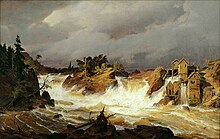Trollhättan Falls

The Trollhättan Falls are waterfalls of the Göta älv in the city of Trollhättan , Västra Götalands län province in Sweden .
In the unregulated state, they extended from the Malgö Bridge to a narrowed valley called Olidan and carried 900 cubic meters of water per second. The lowest section was also known as " Hellfall ". The height difference is 32 meters and is therefore the major part of the drop height of the Göta älv between Vänern and Kattegat , which is 44 meters.
Nowadays the water is only channeled through this route on special occasions, either to regulate the water level of Lake Vänern or as a tourist attraction, with the amount of water being around 300 cubic meters per second. The water is then passed over four gates , which are opened one after the other. This takes place once a week in May, June and September and daily in July and August. Otherwise, the largest amount of water in the two hydropower plants, Hojum and Olidan , located east of the river and thus on the left bank of it, is used to generate electricity.
The power of the river was already used by small businesses on the eastern bank of the river. Over the centuries, the Trollhättan waterfalls have delighted visitors from near and far and the spectacle has been portrayed by Esaias Tegnér and Carl von Linné , among others . The Trollhättan hydropower plant is the origin of the Vattenfall company .
Individual evidence
- ↑ Trollhatten Traps . Retrieved on February 21, 2018 ( page no longer available , search in web archives )
Web links
- Tourist information
- Historical picture of the power station at the waterfalls. Archived from the original on February 6, 2006 ; Retrieved January 4, 2012 .
Coordinates: 58 ° 16 ′ 48 ″ N , 12 ° 16 ′ 38 ″ E
